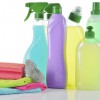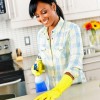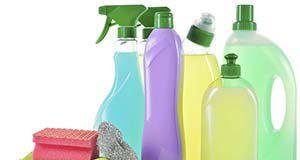Some products that we use in our homes contain chemicals that are hazardous or toxic. We can reduce the potential for exposure to chemicals from household products and produce less hazardous household waste by using alternatives that are relatively free of toxic effects. This six-page fact sheet describes some alternatives that are relatively free of toxic effects. Written by Marie Hammer, Chris Koehler, and Randall Cantrell and published by the Department of Family, Youth and Community Sciences.
http://edis.ifas.ufl.edu/he791
Tag: Housecleaning
Homemade Household Cleaners
 Are you on a budget? Running low on those household cleaners? Instead of heading to the store to buy those more expensive cleaners, make your own! Many homemade household cleaners can be made with just a few inexpensive products that will last a lot longer. This 3-page fact sheet was written by Amanda Griffin and Randall A. Cantrell, and published by the UF Department of Family Youth and Community Sciences, October 2014. (Photo: iStock/Thinkstock.com)
Are you on a budget? Running low on those household cleaners? Instead of heading to the store to buy those more expensive cleaners, make your own! Many homemade household cleaners can be made with just a few inexpensive products that will last a lot longer. This 3-page fact sheet was written by Amanda Griffin and Randall A. Cantrell, and published by the UF Department of Family Youth and Community Sciences, October 2014. (Photo: iStock/Thinkstock.com)
http://edis.ifas.ufl.edu/fy1449
Food Safety: Does Your Kitchen Pass the Test?
 Older adults are at increased risk for foodborne illness. To help reduce your risk, follow safe food handling practices at home. How does your kitchen measure up? This 3-page fact sheet was written by Linda B. Bobroff and Jennifer Hillan, and published by the UF Department of Family Youth and Community Sciences, October 2013.
Older adults are at increased risk for foodborne illness. To help reduce your risk, follow safe food handling practices at home. How does your kitchen measure up? This 3-page fact sheet was written by Linda B. Bobroff and Jennifer Hillan, and published by the UF Department of Family Youth and Community Sciences, October 2013.
http://edis.ifas.ufl.edu/fy926
Cleaning and Sanitizing the Kitchen: Using Inexpensive Household Food-Safe Products (FCS8OH2010/FY1280)
Consumers can protect themselves by preventing the spread of germs by both cleaning and sanitizing surfaces where food is prepared. This 3-page fact sheet provides instructions for sanitizing with bleach, vinegar, or hydrogen peroxide; and how to purchase “green” sanitizing products. Written by Janet Buffer, Lydia Medeiros, Mary Schroeder, Patricia Kendall, Jeff LeJeune, and John Sofos; adapted by Amy Simonne for use in Florida with permission, and published by the UF Department of Family Youth and Community Sciences, February 2012.
http://edis.ifas.ufl.edu/fy1280
